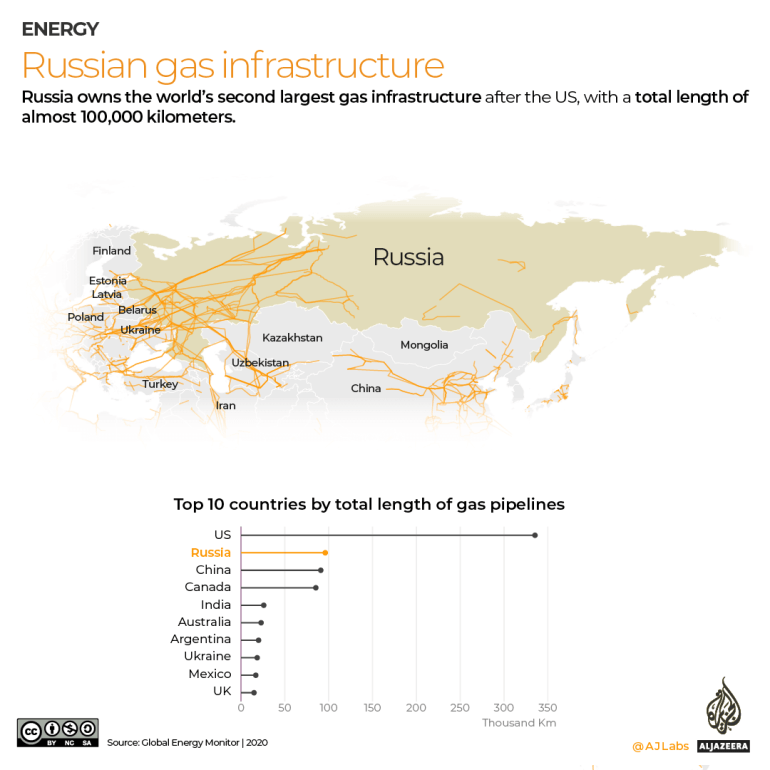Infographic: How much of your country’s gas comes from Russia?
Russia is the world’s largest exporter of gas, accounting for about 45% of the European Union’s imports in 2021.
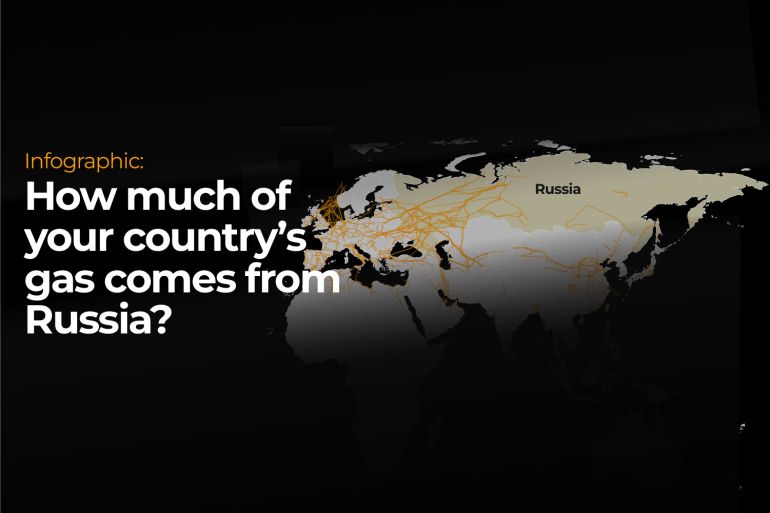
Oil and gas prices have surged following Russia’s invasion of Ukraine on February 24.
The United States has banned imports of oil and gas and the United Kingdom is phasing out oil imports as part of a series of Western sanctions aimed at cutting off Russia from the world’s financial arteries. The European Union, meanwhile, has said it will move to end its reliance on Russian gas.
Keep reading
list of 4 itemsRussia’s invasion of Ukraine: List of key events from day 22
Attacks on Mariupol theatre, pool sheltering ‘hundreds’ of people
How is the media viewing Russia’s war in Ukraine?
In 2020, the world consumed 3,822.8 billion cubic metres (bcm) of natural gas, according to the BP Statistical Review of World Energy 2021. The United States alone accounted for more than 20 percent (832 bcm) of the world’s annual gas consumption, followed by Russia (411.4 bcm), and China (330.6 bcm).
Russia has the largest reserves of natural gas followed by Iran and Qatar. Together, the three countries accounted for half of the world’s natural gas reserves in 2020.
Russia has proven reserves of about 48,938 bcm, Iran of 34,077 bcm, and Qatar of 23,831 bcm.
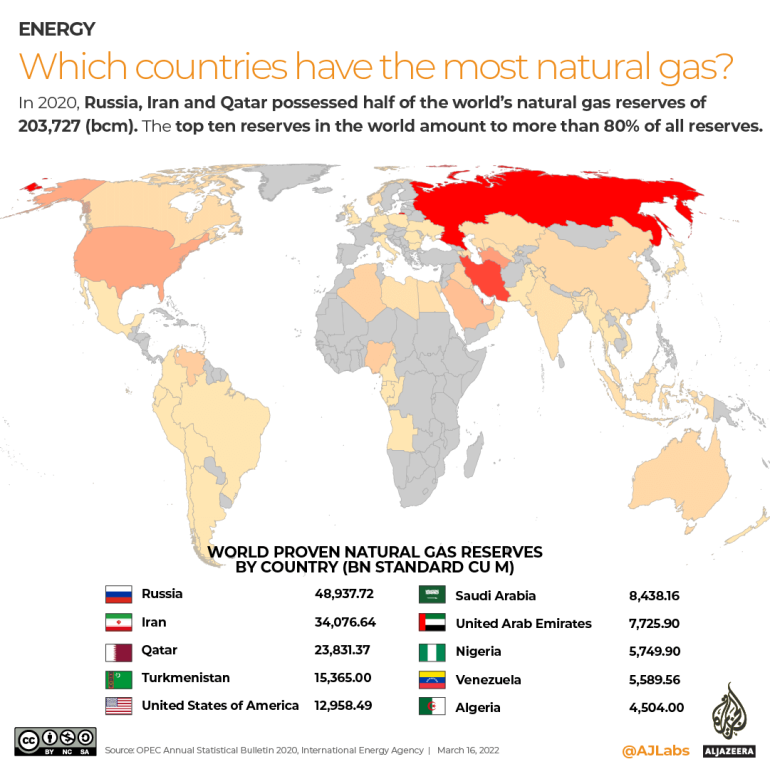
Which countries export the most natural gas?
Unlike the Organization of the Petroleum Exporting Countries (OPEC), there is not a multinational organisation for major gas exporters that adjusts supply to balance the market.
However, the Gas Exporting Countries Forum (GECF) exists as an 11-member organisation comprising Algeria, Bolivia, Egypt, Equatorial Guinea, Iran, Libya, Nigeria, Qatar, Russia, Trinidad and Tobago and Venezuela.
Angola, Azerbaijan, Iraq, Malaysia, Mozambique, Norway, Peru and the United Arab Emirates have the status of observer members. The consortium represents 71 percent of the world’s proven natural gas reserves.
More than 80 percent of global exports in gas is tied to 10 major exporters. In 2020, the 10 largest gas exporters in the world were Russia (199,928 mcm), United States (149,538 mcm), Qatar (143,700 mcm), Norway (112,951 mcm), Australia (102,562 mcm), Canada (70,932 mcm), Germany (50,092 mcm), Netherlands (39,976 mcm), Algeria (34,459 mcm) and Nigeria (35,586 mcm).
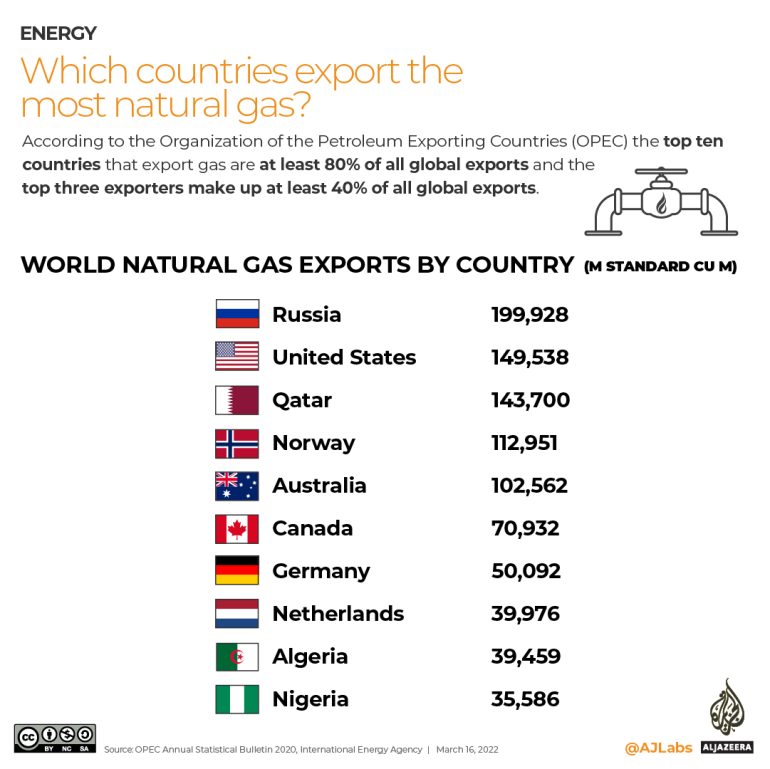
Which countries directly import the most Russian natural gas?
In 2019, the world’s top exporters of natural gas were Australia ($34bn), Qatar ($27.5bn), Russia ($24.5bn), Norway ($21bn) and the US ($16bn).
Italy bought about one-quarter (24 percent) of Russia’s total natural gas exports worth $5.8bn. This made up only 39 percent of the country’s natural gas imports.
At least 37 countries directly imported Russian gas in 2019. The countries directly importing the most Russian natural gas include: Belarus, Bosnia and Herzegovina, Norway and Serbia – each importing about 99 percent of their natural gas from Russia.
The graphic below shows how much of each country’s total natural gas imports came directly from Russia in 2019.
How is gas used and produced?
Natural gas is used in transportation, to generate electricity and heat homes, as well as in the industrial sector to produce raw materials such as glass, plastics and paint, among other things.
Odourless and colourless, natural gas forms over millions of years from decomposed organisms, silt and sand, which then become exposed to heat and pressure under the Earth’s surface.
Methane is the largest component of natural gas, which also contains smaller amounts of natural gas liquids and gases such as carbon dioxide and water vapour.
Gas is extracted by drilling vertically or horizontally into the ground, allowing gas to flow up through wells to the surface. From the wells, natural gas is then sent to processing plants where water vapour and non-hydrocarbon compounds are removed and NGL (natural gas liquid) is separated from wet gas. It is then distributed to consumers via a network of pipelines.
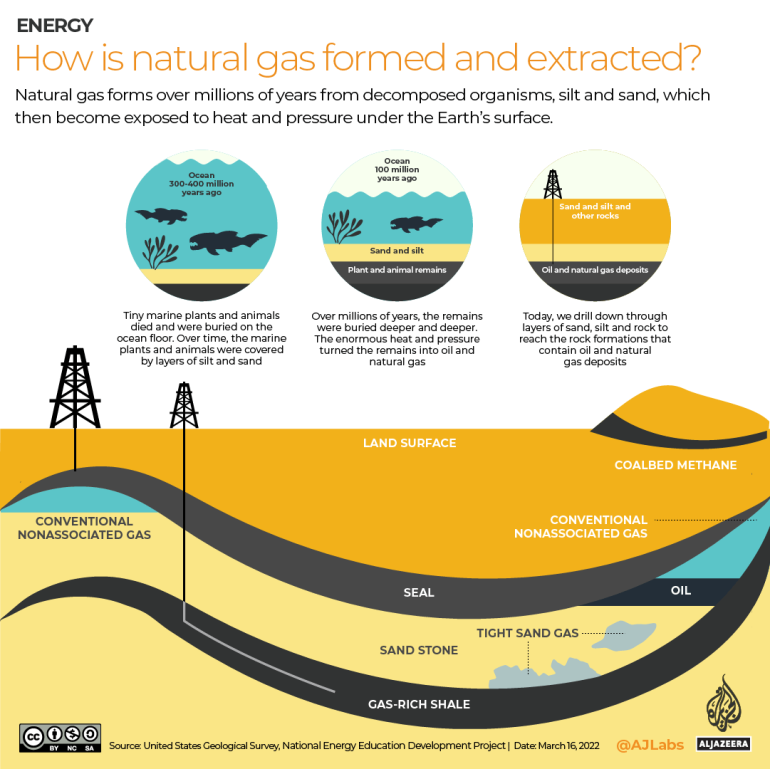
European reliance on Russian gas
Russia owns the world’s second-largest gas infrastructure after the US with a total length of almost 100,000km (62,137 miles).
In 2021, European imports of gas from Russia were more than 380 million cubic metres (mcm) per day via pipeline, totalling about 140 bcm for the year, according to the IEA. An additional 15 bcm was delivered in liquified natural gas (LNG) form. Russia accounted for about 45 percent of the EU’s gas imports and 40 percent of its entire gas consumption.
The EU has announced a strategy to reduce its reliance on gas from Russia by two-thirds by the end of 2022. The REPowerEU plan aims to find alternative supplies of gas and greener energy sources.
Russia’s footmark on the global oil and gas market is significant and with tough sanctions on Russia’s energy sector the effects are being felt globally. Gas prices in Europe and the UK spiked significantly in March after the invasion, but they have since consolidated as Russia and Ukraine engaged in peace talks.
